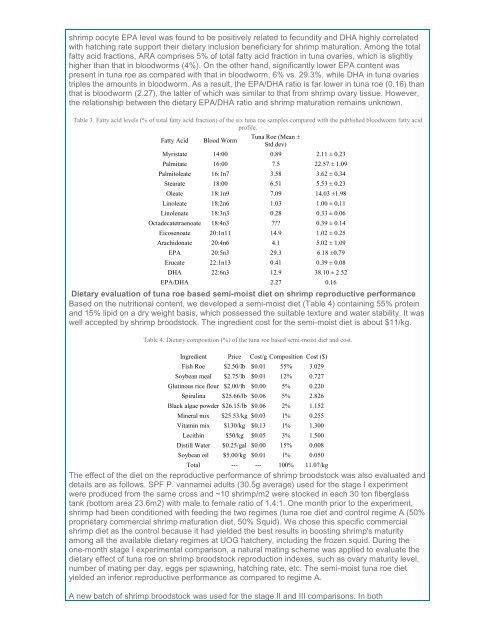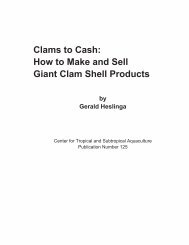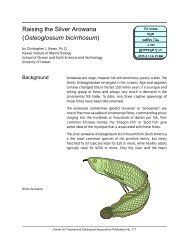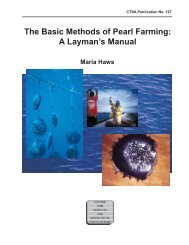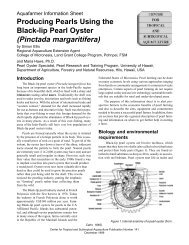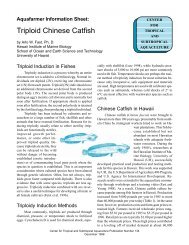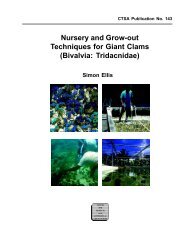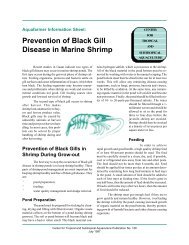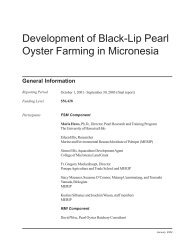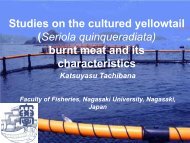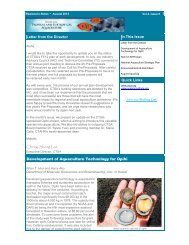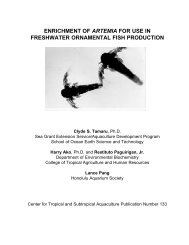Letter from the Director Cheng-Sheng Lee In This Issue ... - CTSA
Letter from the Director Cheng-Sheng Lee In This Issue ... - CTSA
Letter from the Director Cheng-Sheng Lee In This Issue ... - CTSA
- No tags were found...
Create successful ePaper yourself
Turn your PDF publications into a flip-book with our unique Google optimized e-Paper software.
shrimp oocyte EPA level was found to be positively related to fecundity and DHA highly correlatedwith hatching rate support <strong>the</strong>ir dietary inclusion beneficiary for shrimp maturation. Among <strong>the</strong> totalfatty acid fractions, ARA comprises 5% of total fatty acid fraction in tuna ovaries, which is slightlyhigher than that in bloodworms (4%). On <strong>the</strong> o<strong>the</strong>r hand, significantly lower EPA content waspresent in tuna roe as compared with that in bloodworm, 6% vs. 29.3%, while DHA in tuna ovariestriples <strong>the</strong> amounts in bloodworm. As a result, <strong>the</strong> EPA/DHA ratio is far lower in tuna roe (0.16) thanthat is bloodworm (2.27), <strong>the</strong> latter of which was similar to that <strong>from</strong> shrimp ovary tissue. However,<strong>the</strong> relationship between <strong>the</strong> dietary EPA/DHA ratio and shrimp maturation remains unknown.Table 3. Fatty acid levels (% of total fatty acid fraction) of <strong>the</strong> six tuna roe samples compared with <strong>the</strong> published bloodworm fatty acidprofile.Tuna Roe (Mean ±Fatty Acid Blood WormStd.dev)Myristate 14:00 0.89 2.11 ± 0.23Palmitate 16:00 7.5 22.57 ± 1.09Palmitoleate 16:1n7 3.58 3.62 ± 0.34Stearate 18:00 6.51 5.53 ± 0.23Oleate 18:1n9 7.09 14.03 ±1.98Linoleate 18:2n6 1.03 1.00 ± 0.11Linolenate 18:3n3 0.28 0.33 ± 0.06Octadecatetraenoate 18:4n3 ??? 0.39 ± 0.14Eicosenoate 20:1n11 14.9 1.02 ± 0.25Arachidonate 20:4n6 4.1 5.02 ± 1.09EPA 20:5n3 29.3 6.18 ±0.79Erucate 22:1n13 0.41 0.39 ± 0.08DHA 22:6n3 12.9 38.10 ± 2.52EPA/DHA 2.27 0.16Dietary evaluation of tuna roe based semi-moist diet on shrimp reproductive performanceBased on <strong>the</strong> nutritional content, we developed a semi-moist diet (Table 4) containing 55% proteinand 15% lipid on a dry weight basis, which possessed <strong>the</strong> suitable texture and water stability. It waswell accepted by shrimp broodstock. The ingredient cost for <strong>the</strong> semi-moist diet is about $11/kg.Table 4. Dietary composition (%) of <strong>the</strong> tuna roe based semi-moist diet and cost.<strong>In</strong>gredient Price Cost/g Composition Cost ($)Fish Roe $2.50/lb $0.01 55% 3.029Soybean meal $2.75/lb $0.01 12% 0.727Glutinous rice flour $2.00/lb $0.00 5% 0.220Spirulina $25.66/lb $0.06 5% 2.826Black algae powder $26.15/lb $0.06 2% 1.152Mineral mix $25.53/kg $0.03 1% 0.255Vitamin mix $130/kg $0.13 1% 1.300Lecithin $50/kg $0.05 3% 1.500Distill Water $0.25/gal $0.00 15% 0.008Soybean oil $5.00/kg $0.01 1% 0.050Total --- --- 100% 11.07/kgThe effect of <strong>the</strong> diet on <strong>the</strong> reproductive performance of shrimp broodstock was also evaluated anddetails are as follows. SPF P. vannamei adults (30.5g average) used for <strong>the</strong> stage I experimentwere produced <strong>from</strong> <strong>the</strong> same cross and ~10 shrimp/m2 were stocked in each 30 ton fiberglasstank (bottom area 23.6m2) with male to female ratio of 1.4:1. One month prior to <strong>the</strong> experiment,shrimp had been conditioned with feeding <strong>the</strong> two regimes (tuna roe diet and control regime A (50%proprietary commercial shrimp maturation diet, 50% Squid). We chose this specific commercialshrimp diet as <strong>the</strong> control because it had yielded <strong>the</strong> best results in boosting shrimp's maturityamong all <strong>the</strong> available dietary regimes at UOG hatchery, including <strong>the</strong> frozen squid. During <strong>the</strong>one-month stage I experimental comparison, a natural mating scheme was applied to evaluate <strong>the</strong>dietary effect of tuna roe on shrimp broodstock reproduction indexes, such as ovary maturity level,number of mating per day, eggs per spawning, hatching rate, etc. The semi-moist tuna roe dietyielded an inferior reproductive performance as compared to regime A.A new batch of shrimp broodstock was used for <strong>the</strong> stage II and III comparisons. <strong>In</strong> both


